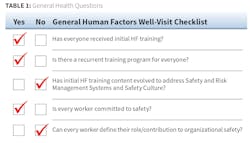Dr. Bill’s Human Factor’s Program Health Checklist
As I sat down to write this article I had a haunting feeling that I am “plowing old ground.” To quote the famous Yogi Berra, “It’s like déjà vu, all over again.” I looked at old AMT magazines, FAA Newsletters, and other magazines searching for papers in which I created a way to affect an internal review of an HF program. I found such a list from a 2001 conference paper presented at a joint FAA-CAA HF Meeting, in London. The paper was titled “Human Factors Programs: Fact or Fantasy?” Borrowing from Shakespeare’s Hamlet, I asked “Is not this something more than fantasy?” In 2001 there were some airline and MRO managers that could do a very good job of describing their corporate human factors programs as if they were real. Fast forward 15 years and human factors programs are not fantasy. Nevertheless, much like we have annual wellness visits to our physicians, we should also conduct annual wellness checkups for our maintenance human factors programs.
Asking the General Questions
Human factors programs, from one organization to another, have considerable differences. One organization may have less than 50 employees, all of whom work on the same day shift. Another may be a very large U.S. carrier like American, Delta, or United. Some MROs have one location. Others have 10+ locations spread around the globe. For those MROs working 7/24, safety hazards are different from other shift schedules and require different human factors programs. There are many standard means by which to measure HF program health. Go to the Acceptable Means of Compliance from the European Aviation Safety Agency or to guidance material from Transport Canada and you will find such information. The international regulatory guidance specifies who should be trained as well as the minimum content areas that must be covered in an HF program. The FAA website, www.humanfactorsinfo.com, likely has the most extensive HF information. These resources make it easy to check if you are meeting minimum guidelines. However, when safety is at stake, it’s more important to examine harder questions that have less concrete answers. That’s where the checkup is important. Table 1 offers broad general health questions for your HF program. The right answers are dependent on your organization.
The Psychoanalytic Questions
The Table 1 questions are high level and force a yes or no response. To drill down on some of those issues, a second series of similar questions may be likened to a psychological part of the well-visit. Here, the goal is to examine the “why” behind the response to the first set of questions. There is no black or white answer to these tougher questions. “I don’t know” is not an acceptable answer. Table 2 includes the harder questions.
About the Data
Following these questions, we must now know how to bring the information together to understand exactly where the HF program stands. Is it healthy? Are there areas of concern? Is a prescription necessary? Do we move forward with general suggestions for improvement without need for serious intervention? All of these questions require a look at the big picture and must address the following question: If our program were to continue as it is, would we have a serious illness with few options for treatment, or would we have some tweaks but overall a clean bill of health?
Part of ensuring that the big picture is reflecting the daily activity of the program is to ensure synergy between those responsible for HF and those responsible for the safety management system (SMS).The combined force must not only review and benefit from post-event reactive data but also help identify and apply data from the SMS proactive and predictive data. Integrating HF interventions and SMS activities within the company helps engineering to ask the right questions and analyze the data accordingly. One example of collecting predictive data is the FAA-A4A Line Maintenance Line Operations Safety Assessment. It capitalizes on peer-to-peer assessments during normal operations. Such systems make everyone a safety auditor.
A health checkup of your HF programs and your safety culture would not be complete without a serious/introspective review of your voluntary reporting system and just culture policies. To fully understand the many hazards inside of your organization you must ask the workers. A good system will ensure constant worker involvement. To fix your hazards you must cooperate to identify, understand, and manage the hazard, threats, and errors. Table 3 has some questions for checking your HF data.
You do not have to be invested in the FAA Aviation Safety Action Program (ASAP) to have a high value employee voluntary reporting system. If you don’t know how to do this, there are plenty of qualified consultants that can assist. Your FAA inspector can draw on FAA personnel to show how to implement a formal or even an informal ASAP.
Did You Pass the Checkup?
Unless you have an EASA Part 145 Certificate, there is no requirement for the HF program health checkup. There is no pass-fail in the U.S. at this time. As the SMS rules become mandatory for air carriers (Part 121) the HF checkup can integrate with all other corporate risk assessments. Of course, it’s not a big deal that you’re not required to have HF training and related HF safety interventions. All companies want to ensure flight safety, protect their employees, and make money. HF interventions are an import means to achieve those goals.
Acknowledgement
The majority of FAA’s maintenance/engineering applied research and development is conducted at the Civil Aerospace Medical Institute in Oklahoma City. The author acknowledges that excellent team of researchers. In particular, the newest team member, Dr. Michelle Bryant, has forced this author to clarify his thinking to ask the checklist questions above.
About the Author

Dr. Bill Johnson
Chief Scientific and Technical Advisor Human Factors in Aviation Maintenance, FAA
““Dr. Bill” Johnson is a familiar name and face to many industry and government aviation audiences. Johnson has been an aviator for over 50 years. He is a pilot, mechanic, scientist/engineer, college professor, and senior executive during his career. That includes 16+ years as the FAA Chief Scientific and Technical Advisor for Human Factors.
Dr. Bill has delivered more than 400 Human Factors speeches and classes in over 50 countries. He has 500 + publications, videos, and other media that serve as the basis for human factors training throughout the world.
Recent significant awards include: The FAA “Charles E. Taylor Master Mechanic” (2020); The Flight Safety Foundation - Airbus “Human Factors in Aviation Safety Award” (2018), and the International Federation of Airworthiness “Sir Francis Whittle Award” (2017).
Starting in 2021 Johnson formed Drbillj.com LLC. In this new venture he continues to bring decades of human factors experience to aviators, worldwide.
